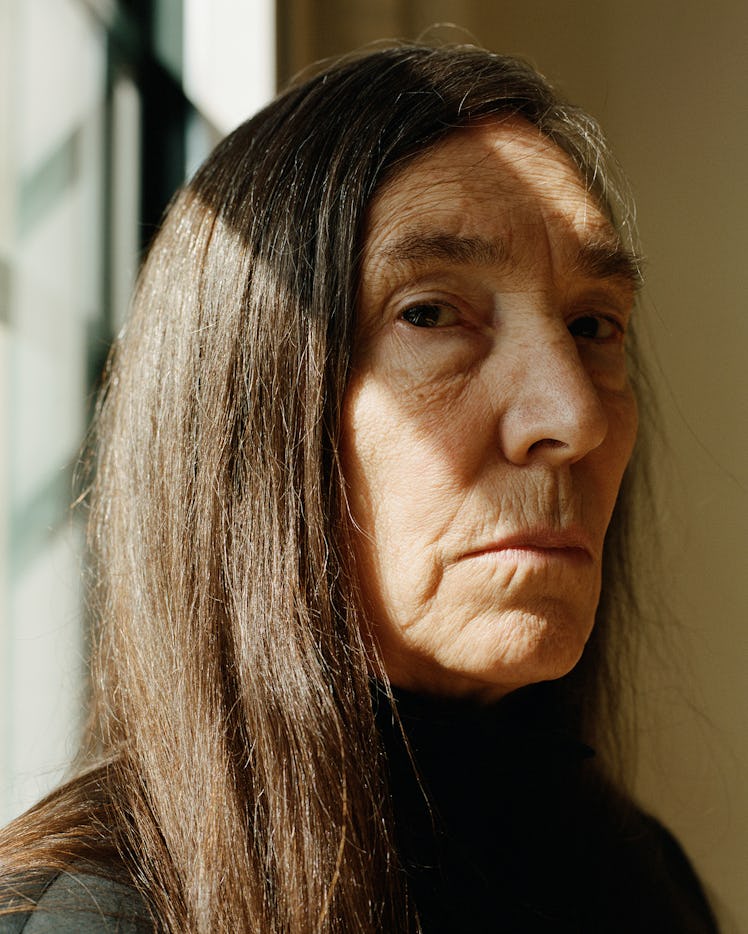Jenny Holzer Goes Beyond Words
The artist, who’s been confronting power through her work for decades, discusses venturing into new tactile territory and embracing AI.

Jenny Holzer has used text as an art form for decades. The artist’s gripping, urgent messages—“Protect me from what I want” and “Abuse of power comes as no surprise”—have been shown all over the world, at museums like the Guggenheim and the Museum of Contemporary Art in Chicago. Since the 1970s, her screeds have been wheat-pasted on the streets of New York City, carved into stone benches, projected onto the Louvre in Paris, and even made it onto condom wrappers. But in 2024, Holzer is venturing into some unfamiliar territory: finger painting.
“I remembered I have hands!” Holzer, 74, tells me on a recent afternoon in her studio in Brooklyn. She points to a group of canvases behind her, covered in black smudged fingerprints, or with two palms pressed into the paper, then dragged downward. “I very seldom touch anything, art-wise. But I thought, last chapter in life—I can smear things. I might as well try.”
Jenny Holzer, Exercise, 2024; Privately Constructed, 2024; Page Denied, 2024
Those “cavewoman art” pieces, as Holzer describes them, are just a few of the works on view for the neo-conceptual artist’s latest solo show at Sprüth Magers gallery in Manhattan, “WORDS.” The exhibition, which is open through November 2, displays Holzer’s pieces on paper—whether a preparatory text for a stone bench carving, drawings from the 1980s, or even paintings. Artworks from past years are also mounted next to newer projects, like an LED installation featuring AI-generated text. (“It was an education to come up with the right prompts for the bots to yield the desired result,” Holzer says.) There are also tracings of government documents included in the show: emails between Donald Trump’s former presidential team during the January 6 storming of the Capitol, redacted CIA papers from the fallout after 9/11, some of which bear instructions on how to torture prisoners of war. For the series, Holzer—who has made politics and corruption a central theme of her practice—printed one of those Trump e-mails, applied it to the canvas, and then covered the text in black handprints.
“When the United States—senior Bush, and then his son—went into the Middle East, I was curious about the what and the why,” Holzer explains. “I thought, if I go to archives of government documents, I could learn from what was written in the moment, when people were unselfconscious. I could learn what wasn’t wholly covered by a journalist—I could have first-person accounts by politicians, people in the military, young soldiers. I needed to know more.”
A work in-progress by Holzer
To sort through the reports and find what she wanted for the show, Holzer employed “people who are brighter and better informed than I am” to comb through those formerly secret documents. “I recall one was about young men training in flight school, and the people there had noticed that they were working on flying, but not landing,” the artist says of one report.
The exhibition feels especially timely, given the upcoming presidential election. But Holzer has been creating art that centers on Donald Trump for many years. Her recent Guggenheim solo show titled “Light Line” featured choice tweets from the former president.
“During the pandemic, we picked the most salient and vivid—kind words—of them,” Holzer says. “We placed the best of the worst tweets on the forms of ancient [Greco-Roman] curse tablets. If you really hated someone, you could have a rolled-up tablet made, and keep it hidden so as to harm your enemy.” When I ask how she’s feeling about November 5, she says, “I am very concerned and certainly not alone there. Hoping for a great collaborative effort to bring out voters to offer their solutions—to offer what’s constructive through their votes and to ideally dismiss very real threats that are present today.”
Jenny Holzer, Survival: Spit all over someone…,1989–2024
If it feels like Holzer speaks in stanzas, almost mimicking the nature of her artworks, it’s because in many ways, she does. But the artist is also extremely jolly, cracking jokes at every turn. Her keen sense of humor seeps into her work but does not detract from its at-times harrowing subject matter. “I would prefer to be Matisse, who made The Joy of Life—stunning painting, and something to celebrate,” she says. “But for a host of reasons, I’m someone who has focused on darker things. And there’s some justification for that, because the joy of life, at least enjoyed moderately, won’t kill you. Whereas the darker practices will. But I believe that forewarned is, to a certain extent, forearmed. I want to know what’s coming down the road, and I want to offer that to others. What do you think? What do you want to do? What might we all do?”
Jenny Holzer, Selection from Truisms: Being happy is…, 2015 (With text from Truisms, 1977–79)
That’s the question posed in “WORDS,” Holzer says, standing up from the mid-century modern table at which we’ve been sitting to show me around the rest of the studio. Sunlight floods through huge windows, casting light on works in progress, some standing on easels and others mounted on the wall. Holzer stops in front of a canvas bearing a rainbow of watercolors—a real departure from the kinds of pieces for which she’s known.
“I tried briefly being a watercolorist and a plain-old painter in the ’70s, and I was so bad at it, I went elsewhere,” she says. “But as the clock ticks, it’s like, what’s to lose?” I note this is the second time she’s alluded to coming to the end of her life, or her career. “Well, yeah,” she replies in a good-natured tone. “But I hope to work until I’m gone-zo. What else am I going to do? It’s boring to just sit around.”